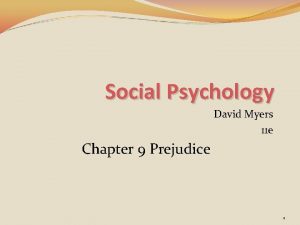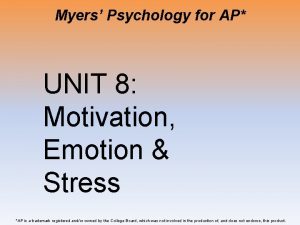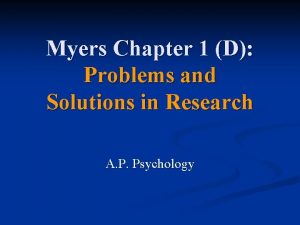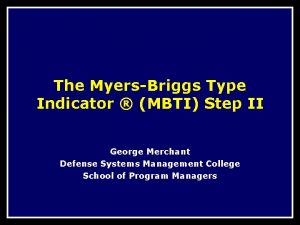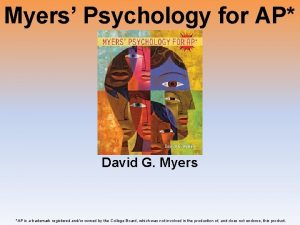Myers Psychology for AP 2 e David G





















































































- Slides: 85

Myers’ Psychology for ® AP , 2 e David G. Myers Power. Point Presentation Slides by Kent Korek Germantown High School Worth Publishers, © 2014 AP® is a trademark registered and/or owned by the College Board ®, which was not involved in the production of, and does not endorse, this product.

Module 55: Freud’s Psychoanalytic Perspective: Exploring the Unconscious

Introduction • Personality

Personality = an individual’s characteristic pattern of thinking, feeling, and acting.


Psychoanalytic Theory’s Core Ideas

Psychoanalytic Theory’s Core Ideas • Parts of the mind – Conscious – Preconscious – Unconscious • Free association • Psychoanalysis • Repression

Unconscious = according to Freud, a reservoir of mostly unacceptable thoughts, wishes, feelings, and memories. According to contemporary psychologists, information processing of which we are unaware.

Free Association = in psychoanalysis, a method of exploring the unconscious in which the person relaxes and says whatever comes to mind, no matter how trivial or embarrassing.

Psychoanalysis = Freud’s theory of personality that attributes thoughts and actions to unconscious motives and conflicts; the techniques used in treating psychological disorders by seeking to expose and interpret unconscious tensions.

Psychoanalytic Theory’s Core Ideas Personality Structure • Personality structure – Id • Pleasure principle – Ego • Reality principle – Superego • conscience

Id = a reservoir of unconscious psychic energy that, according to Freud, strives to satisfy basic sexual and aggressive drives. The id operates on the pleasure principle, demanding immediate gratification.

Ego = the largely conscious, “executive” part of personality that, according to Freud, mediates among the demands of the id, superego, and reality. The ego operates on the reality principle, satisfying the id’s desires in ways that will realistically bring pleasure rather than pain.

Superego = the part of personality that, according to Freud, represents internalized ideals and provides standards for judgment (the conscience) and for future aspirations.

Psychoanalytic Theory’s Core Ideas Personality Development • Psychosexual stages – Oral – Anal – Phallic – Latency – Genital

Psychosexual Stages = the childhood stages of development, (oral, anal, phallic, latency, genital) during which, according to Freud, the id’s pleasure-seeking energies focus on distinct erogenous zones.

Psychoanalytic Theory’s Core Ideas Personality Development

Psychoanalytic Theory’s Core Ideas Personality Development • • • Erogenous zones Oedipus complex Electra complex Identification Gender identity Fixation

Oedipus Complex = according to Freud, a boy’s sexual desires toward his mother and feelings of jealousy and hatred for the rival father.

Identification = the process by which, according to Freud, children incorporate their parent’s values into their developing superegos.

Fixation = according to Freud, a lingering focus of pleasure-seeking energies at an earlier psychosexual state, in which conflicts were unresolved.

Psychoanalytic Theory’s Core Ideas Defense Mechanisms • Defense mechanisms – Repression – Regression – Reaction formation – Projection – Rationalization – Displacement – Sublimation – Denial

Defense Mechanisms = in psychoanalytic theory, the ego’s protective methods of reducing anxiety by unconsciously distorting reality.

Repression = in psychoanalytic theory, the basic defense mechanism that banishes from consciousness anxiety-arousing thoughts, feelings, and memories.

Evaluating Freud’s Psychoanalytic Perspective • Contradictory Evidence • Is repression a myth? • Modern challenges to repression


The Neo-Freudian and Psychodynamic Theorists • Psychodynamic theory • Neo-Freudians – Adler’s inferiority complex – Horney’s sense of helplessness – Jung’s collective unconscious

Psychodynamic Theories = modern-day approaches that view personality with a focus on the unconscious and the importance of childhood experiences.

Collective Unconscious = Carl Jung’s concept of a shared, inherited reservoir of memory traces from our species’ history.

Assessing Unconscious Processes • Projective Test – Thematic Apperception Test (TAT) – Rorschach Inkblot Test

Projective Test = a personality test, such as the Rorschach, that provides ambiguous stimuli designed to trigger projection of one’s inner dynamics.

Thematic Apperception Test (TAT) = a projective test in which people express their inner feelings and interests through the stories they make up about ambiguous scenes.

Rorschach Inkblot Test = the most widely used projective test, a set of 10 inkblots, designed by Hermann Rorschach; seeks to identify people’s inner feelings by analyzing their interpretations of the blots.

The Modern Unconscious Mind • False consensus effect • Terror management theory

False Consensus Effect = the tendency to overstimulate the extent to which others share our beliefs and our behaviors.

Terror-Management Theory = a theory of death-related anxiety; explores people’s emotional and behavioral responses to reminders of their impending death.


Introduction • Humanistic Theories

Humanistic Theories = view personality with a focus on the potential for healthy personal growth.

Abraham Maslow’s Self. Actualizing Person • Abraham Maslow – Self-actualization – Self-transcendence – Peak experiences

Self-Actualization = according to Maslow, one of the ultimate psychological needs that arises after basic physical and psychological needs are met and self-esteem is achieved; the motivation to fulfill one’s potential.

Carl Rogers’ Person-Centered Perspective • Carl Rogers – Growth promoting climate • Genuineness • Acceptance • Empathy – Unconditional positive regard – Self-concept

Unconditional Positive Regard = according to Rogers, an attitude of total acceptance toward another person.

Self-Concept = all our thoughts and feelings about ourselves, in answer to the question, “Who am I? ”

Assessing the Self • Self-report tests • Ideal versus actual self

Evaluating Humanistic Theories • Renewed interest in self-concept • Criticisms – Vague and subjective – Individualistic and biased – Naïve Western


Exploring Traits • Trait – Describing rather than explaining – Myers-Briggs Type Indicator (MBTI)

Trait = a characteristic pattern of behavior or a disposition to feel and act, as assessed by self-report inventories and peer reports.

Exploring Traits Factor Analysis • Factor analysis – Eysenck and Eysenck • Extroversion versus introversion • Emotional stability versus instability • Eysenck Personality Questionnaire

Exploring Traits Factor Analysis

Exploring Traits Biology and Personality • Brain scans – Brain arousal • Genetics – Autonomic nervous system reactivity

Assessing Traits • Personality inventory – Minnesota Multiphasic Personality Inventory (MMPI) • Empirically derived test • Objective test • Lie scale

Personality Inventory = a questionnaire (often true-false or agreedisagree items) on which people respond to items designed to gauge a wide range of feelings and behaviors; used to assess selected personality traits.

Minnesota Multiphasic Personality Inventory (MMPI) = the most widely researched and clinically used of all personality tests. Originally developed to identify emotional disorders (still considered its most appropriate use), this test is now used for many other screening purposes.

Empirically Derived Test = a test (such as the MMPI) developed by testing a pool of items and then selecting those that discriminate between groups.

The Big Five Factors • The Big Five – Conscientiousness – Agreeableness – Neuroticism • Emotional stability vs instability – Openness – Extraversion


Evaluating Trait Theories The Person-Situation Controversy • Person-situation controversy – Are traits consistent? – Can traits predict behavior?


Social-Cognitive Theories • Social-cognitive perspective – behavioral approach

Social-Cognitive Perspective = views behavior as influenced by the interaction between people’s traits (including their thinking) and their social context.

Behavioral Approach = in personality theory, this perspective focuses on the effects of learning on our personality development.

Social-Cognitive Theories Reciprocal Influences • Reciprocal determinism

Reciprocal Determinism = the interacting influences of behavior, internal cognition, and environment.

Social-Cognitive Theories Reciprocal Influences • Ways individuals and the environment interact – Different people choose different environments – Out personalities shape how we interpret and react to events – Our personality help create situations to which we react

Social-Cognitive Theories Optimism versus Pessimism • Optimism and Health • Excessive Optimism • Blindness to one’s own incompetence • Positive psychology

Positive Psychology = the scientific study of optimal human functioning; aims to discover and promote strengths and virtues that enable individuals and communities to thrive.

Social-Cognitive Theories Assessing Behavior in Situations • US Army spy training • Business use of simulations

Social-Cognitive Theories Evaluating Social-Cognitive Theories • Based on research • Focuses too much on the situation

Comparing the Major Personality Theories


Exploring the Self • Self – Possible selves – Spotlight effect

Self = in contemporary psychology, assumed to be the center of personality, the organizer of our thoughts, feelings, and actions.

Spotlight Effect = overestimating other’s noticing and evaluating our appearance, performance, and blunders (as if we presume a spotlight shines on us).

Exploring the Self The Benefits of Self-Esteem • Self-efficacy

Self-Esteem = one’s feelings of high or low self-worth.

Self-Efficacy = one’s sense of competence and effectiveness.

Exploring the Self-Serving Bias • Self-serving bias – People accept more responsibility for good deeds than for bad, successes than failures – Most people see themselves as better than average • Defensive self-esteem • Narcissism

Self-Serving Bias = a readiness to perceive oneself favorably.

Narcissism = excessive self-love and self-absorption.

Exploring the Self Culture and the Self • Individualism • Collectivism

Individualism = giving priority to one’s own goals over group goals and defining one’s identity in terms of personal attributes rather than group identifications

Collectivism = giving priority to the goals of one’s group (often one’s extended family or work group) and defining one’s identity accordingly.

Exploring the Self Culture and the Self
 David myers psychology 9th edition
David myers psychology 9th edition Psychology eighth edition david g myers
Psychology eighth edition david g myers David g myers psychology 8th edition
David g myers psychology 8th edition General adaptation syndrome
General adaptation syndrome Psychology tenth edition david g myers
Psychology tenth edition david g myers Self-perpetuating prejudgments
Self-perpetuating prejudgments Unit 8 myers ap psychology
Unit 8 myers ap psychology Myers psychology for ap
Myers psychology for ap Myers' psychology for ap solutions
Myers' psychology for ap solutions Psychology in everyday life myers
Psychology in everyday life myers Myers' psychology for ap
Myers' psychology for ap Kontinuitetshantering i praktiken
Kontinuitetshantering i praktiken Typiska novell drag
Typiska novell drag Tack för att ni lyssnade bild
Tack för att ni lyssnade bild Returpilarna
Returpilarna Varför kallas perioden 1918-1939 för mellankrigstiden?
Varför kallas perioden 1918-1939 för mellankrigstiden? En lathund för arbete med kontinuitetshantering
En lathund för arbete med kontinuitetshantering Särskild löneskatt för pensionskostnader
Särskild löneskatt för pensionskostnader Vilotidsbok
Vilotidsbok Sura för anatom
Sura för anatom Förklara densitet för barn
Förklara densitet för barn Datorkunskap för nybörjare
Datorkunskap för nybörjare Stig kerman
Stig kerman Hur skriver man en debattartikel
Hur skriver man en debattartikel Delegerande ledarskap
Delegerande ledarskap Nyckelkompetenser för livslångt lärande
Nyckelkompetenser för livslångt lärande Påbyggnader för flakfordon
Påbyggnader för flakfordon Tryck formel
Tryck formel Svenskt ramverk för digital samverkan
Svenskt ramverk för digital samverkan Bo bergman jag fryser om dina händer
Bo bergman jag fryser om dina händer Presentera för publik crossboss
Presentera för publik crossboss Teckenspråk minoritetsspråk argument
Teckenspråk minoritetsspråk argument Bat mitza
Bat mitza Treserva lathund
Treserva lathund Epiteltyper
Epiteltyper Claes martinsson
Claes martinsson Cks
Cks Byggprocessen steg för steg
Byggprocessen steg för steg Bra mat för unga idrottare
Bra mat för unga idrottare Verktyg för automatisering av utbetalningar
Verktyg för automatisering av utbetalningar Rutin för avvikelsehantering
Rutin för avvikelsehantering Smärtskolan kunskap för livet
Smärtskolan kunskap för livet Ministerstyre för och nackdelar
Ministerstyre för och nackdelar Tack för att ni har lyssnat
Tack för att ni har lyssnat Vad är referatmarkeringar
Vad är referatmarkeringar Redogör för vad psykologi är
Redogör för vad psykologi är Borstål, egenskaper
Borstål, egenskaper Atmosfr
Atmosfr Borra hål för knoppar
Borra hål för knoppar Orubbliga rättigheter
Orubbliga rättigheter Relativ standardavvikelse formel
Relativ standardavvikelse formel Tack för att ni har lyssnat
Tack för att ni har lyssnat Steg för steg rita
Steg för steg rita Informationskartläggning
Informationskartläggning Tobinskatten för och nackdelar
Tobinskatten för och nackdelar Toppslätskivling effekt
Toppslätskivling effekt Mästare lärling modell
Mästare lärling modell Egg för emanuel
Egg för emanuel Elektronik för barn
Elektronik för barn Antikt plagg i rom
Antikt plagg i rom Strategi för svensk viltförvaltning
Strategi för svensk viltförvaltning Var 1721 för stormaktssverige
Var 1721 för stormaktssverige Indikation för kejsarsnitt på moderns önskan
Indikation för kejsarsnitt på moderns önskan Ro i rom pax
Ro i rom pax Tack för att ni lyssnade
Tack för att ni lyssnade Mindre än tecken
Mindre än tecken Bunden och fri form
Bunden och fri form Inköpsprocessen steg för steg
Inköpsprocessen steg för steg Rbk mätning
Rbk mätning Etik och ledarskap etisk kod för chefer
Etik och ledarskap etisk kod för chefer Slyngexcision
Slyngexcision Myndigheten för delaktighet
Myndigheten för delaktighet Frgar
Frgar Tillitsbaserad ledning
Tillitsbaserad ledning Läkarutlåtande för livränta
Läkarutlåtande för livränta Karttecken brunn
Karttecken brunn Gumman cirkel sång
Gumman cirkel sång Vishnuismen
Vishnuismen Vad är vanlig celldelning
Vad är vanlig celldelning Bris för vuxna
Bris för vuxna Bamse för de yngsta
Bamse för de yngsta What is the poem love that boy about
What is the poem love that boy about Bad boy walter dean myers summary
Bad boy walter dean myers summary Bad boy walter dean myers summary
Bad boy walter dean myers summary Mbti step ii
Mbti step ii Binary counting sequence
Binary counting sequence





